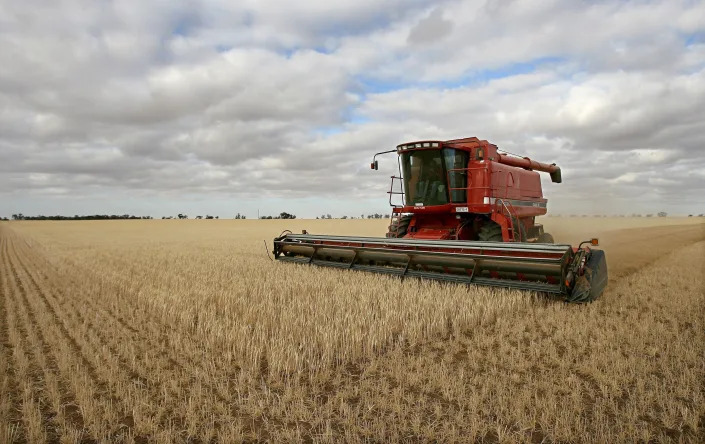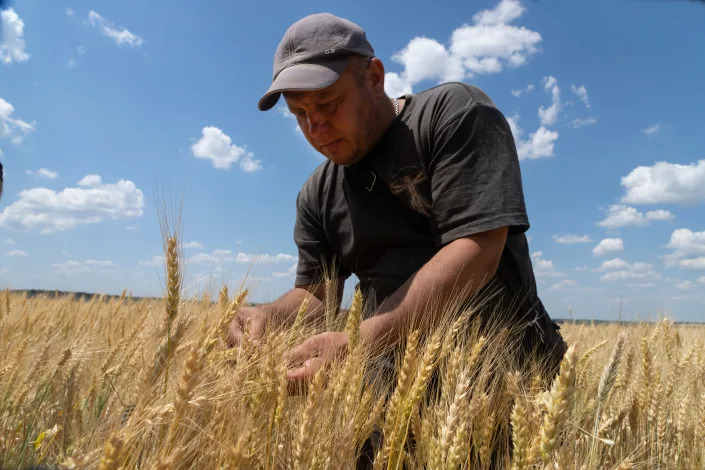
Soybean fields in Wisconsin are pictured in 2018
Mon, June 27, 2022 at 4:08 AM·5 min read
By Tom Polansek
CHICAGO (Reuters) - U.S. farmers have cut back on using common weedkillers, hunted for substitutes to popular fungicides and changed planting plans over persistent shortages of agricultural chemicals that threaten to trim harvests.
Spraying smaller volumes of herbicides and turning to less-effective fungicides increase the risk for weeds and diseases to dent crop production at a time when global grain supplies are already tight because the Ukraine war is reducing the country's exports.
Interviews with more than a dozen chemical dealers, manufacturers, farmers and weed specialists showed shortages disrupted U.S. growers' production strategies and raised their costs.
Shawn Inman, owner of distributor Spinner Ag Incorporated in Zionsville, Indiana, said supplies are the tightest in his 24-year career.
"This is off the charts," Inman said. "Everything was delayed, delayed, delayed."
Shortages further reduce options for farmers battling weeds that developed resistance to glyphosate, the key ingredient in the commonly used Roundup herbicide, after decades of overuse in the United Sates.
Prices for glyphosate and glufosinate, another widely used herbicide sold under the brand Liberty, jumped more than 50% from last year, dealers said, padding profit at companies like Bayer AG, BASF SE and Corteva Inc.
The U.S. Agriculture Department said it heard from farmers and food companies concerned about whether agribusinesses are hiking prices for goods like chemicals, seeds and fertilizer to boost profit, not simply because of supply and demand factors. The agency has launched an inquiry into competition in the sector, and some watchdog groups said it is moving too slowly.
Agrichemical companies blame the COVID-19 pandemic, transportation delays, a lack of workers and extreme weather for shortages. Fertilizer and some seeds are also in short supply globally.
SUPPLY CHAIN STALLED
More difficulties are on the horizon, as BASF, which formulates glufosinate, told Reuters the supply situation will not improve significantly next year.
"It's going to take more time than what our customers, farmers and retailers would have thought," said Scott Kay, vice president of U.S. crops for BASF.
Tennessee farmer Jason Birdsong said he abandoned plans to plant soybeans on 100 acres after waiting months to receive Liberty he ordered from Nutrien Ag Solutions. He ultimately received less than half his order for 125 gallons and planted corn on the land instead. Birdsong said he is better able to control weeds in corn than soybeans.
Nutrien said numerous events stalled the supply chain during the pandemic and the company provided alternate solutions to customers.
Birdsong said he needed Liberty to fight weeds that are resistant to glyphosate in soy fields. He said he ruled out a third option, a dicamba-based herbicide from Bayer, because of extensive federal restrictions on when and where dicamba can be sprayed.
"With the dicamba technology being so strict, Liberty is the go-to," Birdsong said.
The Environmental Protection Agency approved new restrictions on dicamba use this year in Iowa and Minnesota, two major farm states. The herbicide, approved in 2016, faces stricter regulations because it drifts onto neighboring farms and damages crops other than Bayer soybeans engineered to resist dicamba.
The rise of a rival Corteva soybean variety, Enlist, is further adding to glufosinate demand because the crop can be sprayed with glufosinate, among other chemicals, dealers said.
Generic versions of glufosinate-based Liberty sold for about $100 a gallon, up from $32 a gallon last year, said Dion Letcher, owner of Letcher Farm Supply in Garden City, Minnesota. The increase reduces farmers' profits from lofty crop prices.
Shortages of Liberty and other products began last year as distributors used backup supplies to offset supply disruptions in 2021, Letcher said. Now, there are no reserves, he said.
"Anything from BASF is short this year," Letcher said. "I'm worried about next year."
AGRICHEMICAL PROFITS CLIMB
For glyphosate, prices reached $50 a gallon to $60 a gallon, up from less than $20 a gallon in mid-2021, said Inman, the owner of Spinner Ag Incorporated.
Bayer reported sales of glyphosate-based products were "particularly strong" in the first quarter as prices increased and volumes declined. Overall, its herbicide sales soared 67% from a year earlier to 2.5 billion euros ($2.64 billion).
BASF's agricultural solutions unit posted quarterly sales of 3.4 billion euros, up 21% from a year earlier. Corteva also sold more than $2 billion worth of crop-protection products, up 23% from a year earlier, as prices rose 11%.
BASF is seeking to acquire raw materials earlier to avoid future shortages, Kay said. Bayer said it broadened its supplier base for raw ingredients and added bulk trucks to deliver products more efficiently. Farmers who cannot find glyphosate and glufosinate are switching to alternatives, Corteva said.
The supply limitations have caused practical headaches for growers.
Indiana farmer Denny Bell said he did not receive Liberty in his usual 250-gallon containers. Instead, he spent seven hours emptying 2.5-gallon jugs into a larger vat before spraying. Bell said he also waited six months for a popular BASF fungicide, Veltyma.
Reduced usage of herbicides this summer could allow weeds that escape crucial early sprayings to grow and spread their seeds in fields, leaving farmers with more weeds to fight for the next two years as the seeds sprout, said Scott Nolte, Texas A&M University weed specialist.
Iowa corn and soy grower Brent Swart said he is opting to use less glyphosate in the mix of chemicals he sprays due to short supplies, but does not expect it to hurt yields.
"There's definitely a different feel to this year," Swart said. "We've never seen as much supply issue."
($1 = 0.9488 euro)
(Reporting by Tom Polansek in Chicago; Editing by Caroline Stauffer and Matthew Lewis)
US wants farmers to boost wheat production amid a global food shortage. They can't afford to
Clay Schemm's great grandfather moved to Kansas in the 1920s with a tractor and not much else.
The cash crop was wheat.
Today, Schemm, 26, continues that tradition at farms in his home of Sharon Springs, Kan. near the state's western border and a few hundred miles away in eastern Kansas.
On the other side of the world, Russia's war in Ukraine has Schemm rethinking this year's harvests, just as the Biden administration is encouraging U.S. farmers to produce more wheat in response to the disruption of the market caused by the war in Ukraine — one of the world's top producers.
But Schemm said it might not be realistic for many reasons: growing seasons that are slow to respond to the unfolding crisis, federal incentives for double-cropping that aren't viable in most of his acres and a volatile wheat market. Wheat prices have fluctuated wildly after it soared for weeks following Russia's February invasion of Ukraine.
"Even that little bit drop in price has me very hesitant to go back in with wheat in the eastern farms," Schemm said.
More: How Russia's war against Ukraine could make our food prices – from bread to beer – more expensive
Biden heads Saturday to Germany for a meeting of the world's most powerful nations that make up the Group of Seven, or G7, where among the top priorities is addressing a global wheat shortage caused by Russia's war in Ukraine.
International organizations warn that current supply disruptions caused by the war are aggravating already high prices, which complicates access to food in some Northern African countries and parts of Asia that are dependent on Ukraine's wheat supply.
Yet even U.S. farmers like Schemm who want to ramp up their production can't do so easily, raising doubts that the U.S. can fill much of the void from Ukraine's wheat supply.
"It's not like in the U.S. we have all these unplanted acres, fields just lying fallow," said Veronica Nigh, senior economist with the American Farm Bureau Federation, which lobbies on behalf of farmers. "That's frustrating. Farmers want to do more. They want to be able to help to respond."
Limits to the push for more double-cropping
Droughts in the Great Plains and heavy rain in Minnesota and the Dakotas have slowed the production of wheat this year. Fertilizer costs have spiked as a result of the war. And the farming calendar presents another problem: Seventy percent of wheat in the U.S comes from a winter harvest – planted in the fall but not harvested until the spring, putting it off track with the immediate crisis in Ukraine.
There are also questions about the effectiveness of how the Biden administration is looking to expand wheat productions.
U.S. Agriculture Secretary Tom Vilsack met with United Nations members last week and relayed efforts by the federal government to encourage a farming process called double-cropping to boost the production of wheat. As an incentive, the Agriculture Department is working to extend federal insurance available to farmers to double-crop wheat to 681 additional counties.

Farmers double-crop when they plant a second crop after harvesting a different crop on the same field within the same growing year. It often involves soybeans and then wheat, or vice versa, and depending on the part of the country, can be wheat on top of wheat. It's a financially risky endeavor for farmers, who aren't likely to pursue double-cropping without insurance.
More: Biden to meet with G-7 leaders in Europe amid global economic crisis, conflict with Russia
But the incentives aren't expected to move the needle much because double-cropping is typically only an option in heavy-moisture areas east of the Mississippi River like Michigan, Ohio, Kentucky and Illinois – not in states like Kanas, Oklahoma and Texas that produce the most wheat in the U.S.
"If they're really wanting to replace the Ukrainian crop, they need to be able to hit our big wheat-producing states as a whole," Schemm said. "And these policies just aren't quite hitting that mark."
A $40 billion Ukraine package that Congress approved in May originally had $500 million earmarked for increasing the domestics production of wheat and other crops through expanded marketing loan rates and double-cropping incentives. The measure was scrapped before the bill's passage over concerns about the practicality of the loan program when it become more expensive amid high inflation.
More: Biden proposes three-month holiday for federal gas tax, but Congress is skeptical
Chandler Goule, CEO of the National Association of Wheat Growers, said if there is an increase in wheat production it would come from the upcoming winter harvest, but cautioned, "You're not going to see a 10%, 15%, 20% increase."
Wheat produced this year in Kansas, Oklahoma and Texas, three of the nation's largest wheat-producing states, is in "very poor to fair" condition as result of the droughts, according to Goule. All three states are lagging behind their three years averages in production. The heavy moisture in the upper Midwest has put Minnesota and the Dakota states behind as well.
Wheat prices are up 27% since the beginning of the year and 11% since Russia's invasion, according to the Department of Agriculture. Many wheat farmers are spooked by a volatile market. Goule said those who do not farm might wrongly assume wheat growers are "falling over themselves to get out there in the field to plant more" to cash in on the high prices.
"Just as fast as that market went up, it has the potential of coming back down," Goule said. "And so really what it does to growers is is the opposite – planting probably less wheat."
What does the rise of wheat prices mean for grocery shopping?
Rattling the global wheat market further, India banned wheat exports in May after excessively hot weather hurt its harvest. Because the U.S. produces most of its wheat domestically, Americans have not faced a shortage like other countries, but the price of wheat in the U.S. has soared nonetheless.
Wheat prices were already on the rise before the war in Ukraine as a result of droughts in the West and Canada, said Chad Hart, an agricultural economist at Iowa State University.
“Then you put this war on top of that, and that sort of is an accelerant to what we’ve seen in terms of prices," he said.
More: 'Americans are anxious': Unrelenting inflation puts pressure on Biden ahead of midterms
Following Russia's Feb. 24 invasion of Ukraine, wheat prices jumped 20% to 25% almost immediately. Since then, price increases have come in waves, with the highest happening in May amid Russia’s blockade of wheat in Ukraine and concerns about Ukrainian wheat producers’ ability to harvest their crop, Hart said.
The price of cereals and bakery products was up 11.6% in May over last year, according to the Labor Department, a slightly higher percentage than the overall 8.6% jump in inflation. But that’s still less than other food items. Eggs, for example, cost 22.6% more than last year. Poultry is up 15.3%, beef and veal jumped 14.3%, and fish and seafood rose 11.9%.

Agriculture Department officials said they are tracking the price of wheat "closely" and acknowledged it could increase more in the coming months.
While food prices could continue to spike as well, it might not be a direct result of wheat.
The reason: food prices in the U.S. are tied more closely to other factors than commodities. Hart predicted the price of wheat will remain elevated for the next 18 months, having some impact on food prices in the U.S. "but not nearly at the scale that you would think.”
“When we look at that dollar we spend at the grocery store, on average only about 15 cents of that dollar actually goes back to buy the commodity from the farmer,” he said. “The other 85 cents is the transportation, the packaging, the advertising, the labor at the grocery store and up the warehouse chain. I make the joke – and it's actually fairly close to true – that we pay more for the cardboard in a box of cornflakes than we do for the corn that's in the box of cornflakes.”
True impact on U.S. wheat from war in Ukraine won't be clear until next year
Rising fertilizer costs have compilated farmers' decisions.
The price of fertilizer, a major Russian export, has more than doubled since last year – an increase the Agriculture Department attributes to multiple factors, including the war in Ukraine. Prices dropped in May but remain higher than normal.
Eddie Melton, a fifth-generation farmer from Sebree, Ky. in the western part of the state, said he expects more wheat planted in Kentucky this fall, but said farmers must also weigh the rising cost of fertilizer and fuel.
“The prices have tripled on a lot of those things, so it’s all kind of relevant,” said Melton, first vice president of the Kentucky Farm Bureau Federation.
Ukraine typically exports most of its wheat through the Black Sea, but blockades by Russian forces along the Ukrainian coast have prevented grains from entering the world market.
John Kirby, National Security Council spokesman, said the U.S. and other G7 countries will use meetings on food security in Germany to discuss ways to get around the blockade. Biden has mentioned building temporary silos on the Ukrainian border, including in Poland, to help facilitate exports.
Kirby also said the U.S. welcomes new involvement by Turkey to try to broker a deal to get grain out of Ukraine.
Melton, who raises corn, soybeans, wheat and beef cattle in Kentucky, said he empathizes with Ukrainian farmers who have seen their operations interrupted because of war.
“Farming is a stressful job in itself, but I can’t imagine what those farmers are going through in Ukraine right now,” he said.
In April, the Biden administration announced plans to provide $282 million in food assistance through the Bill Emerson Humanitarian Trust – draining its entire balance – to countries affected by Russia's war in Ukraine. The fund, created in 2018, is the primary way the U.S. provides food-insecure countries direct aid during crises.
But those dollars can only go so far.
With the U.S. wheat supply down slightly because of weather challenges, the Department of Agriculture expects U.S. exports to drop as well over the next year to about 775 million metric tons, down from 779 million metric tons. The wheat harvested this summer – soon to be going on the market – was planted last fall before the war in Ukraine.
The first true picture of the war in Ukraine's impact on U.S. wheat production won't be known until this fall, when wheat farmers make their decisions about the winter harvest. It will be the first major harvest since the Russian invasion.
"That decision will be made in the next couple of months," said Nicole Berg, a fourth-generation wheat farmer in Paterson, Wa., who hopes the past year's weather troubles don't repeat itself.
"Farmers, luckily, are internal optimists," Berg, who serves as president of the National Association of Wheat Growers, added. "We always think we're going to get that best price."
Schemm, who spent $67,000 more on fertilizer this year than last, said other farmers he knows are "cautiously optimistic" that they will be able to devote more acres to wheat. He said more farmers are "starting to look at wheat again" and he knows "farmers are interested in it."
But their decisions will come down to many factors, Schemm said. And the uncertainty, sure doesn't help.
Reach Joey Garrison on Twitter @joeygarrison and Michael Collins @mcollinsNEWS.
This article originally appeared on USA TODAY: US wheat farmers face hurdles to help fill Ukraine's void




